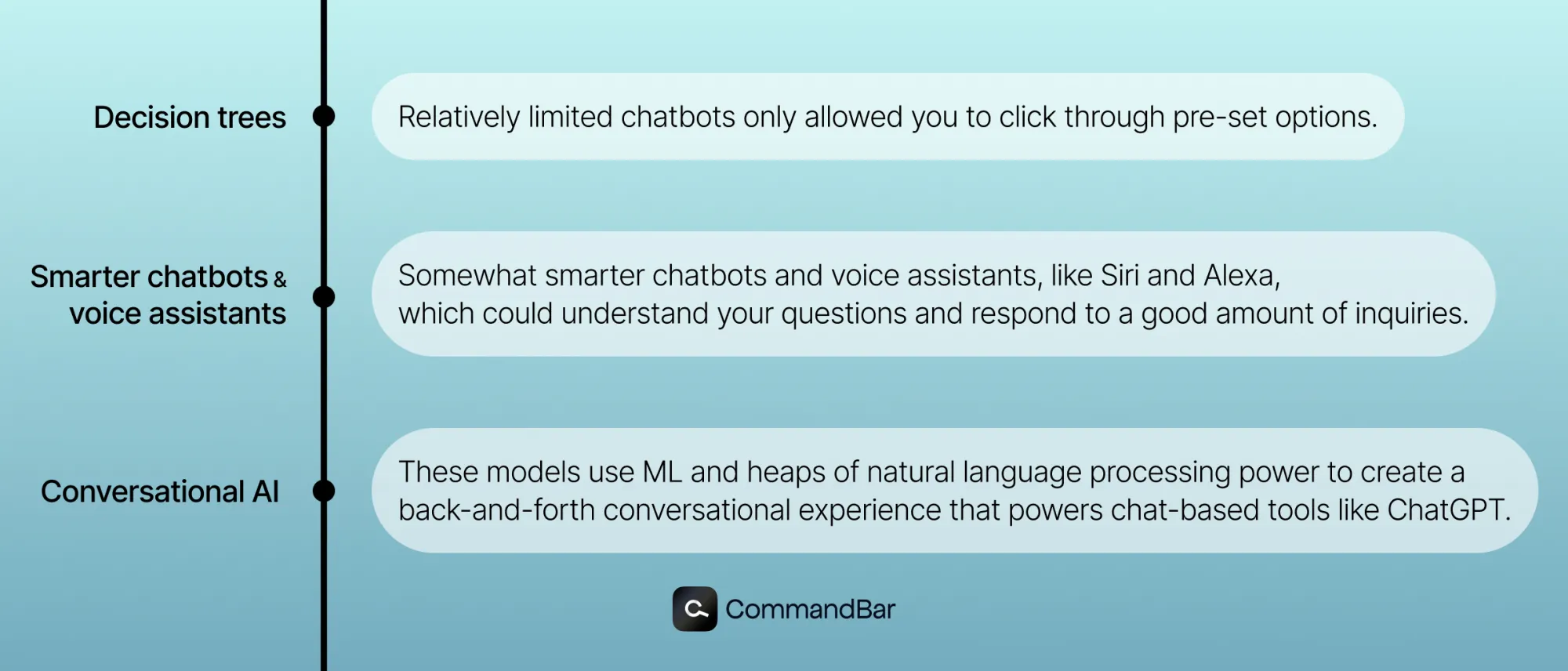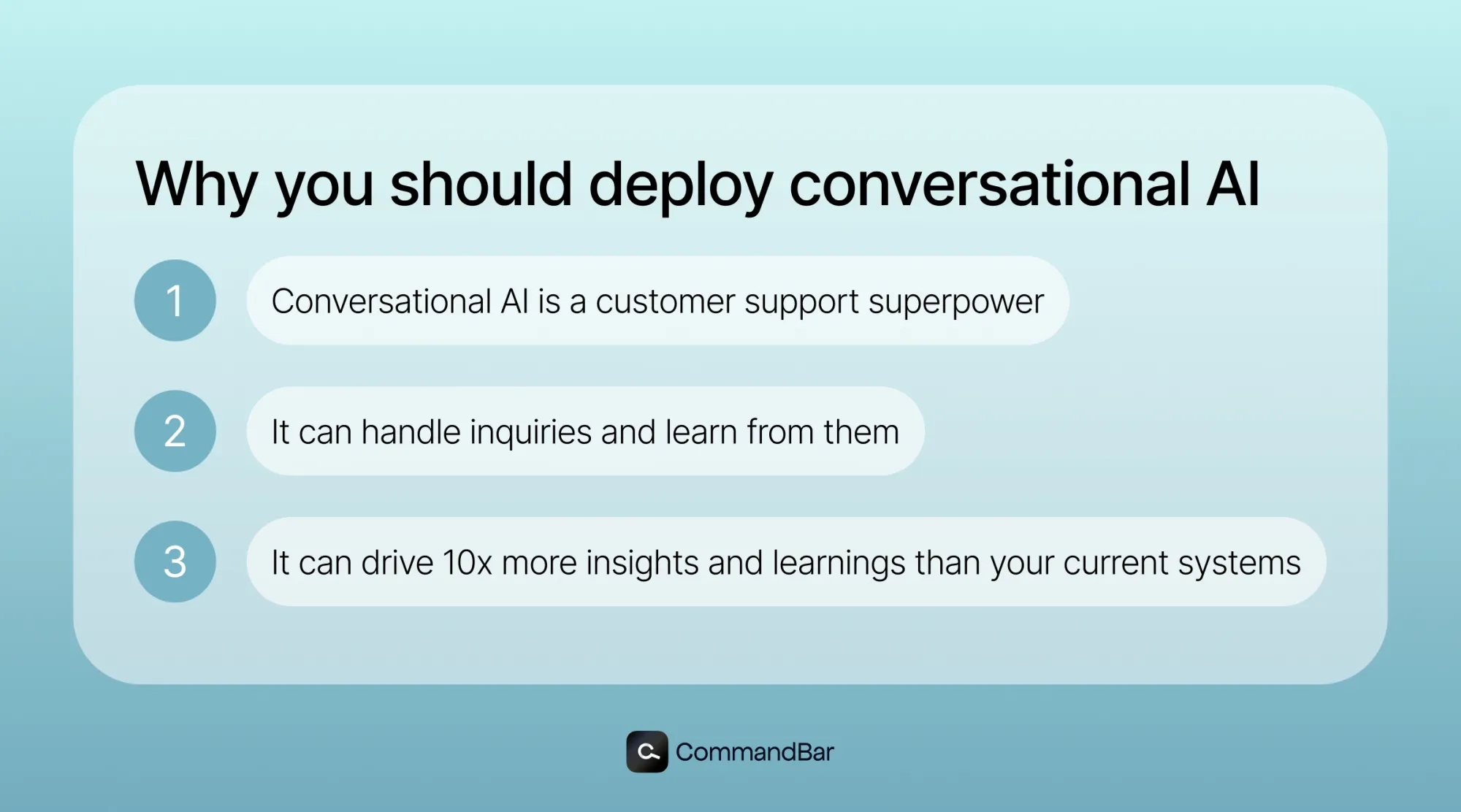Conversational AI is all the rage right now, and for good reason.
It's changing how users interact with software and fundamentally reframing what's possible for support, user onboarding, and user activation.
However, with so many conversational AI tools now available and differing theories on how to best implement them, it can take time to understand how to best deploy conversational AI into your specific product for your specific needs.
Let's dig into how to deploy the best conversational AI experience for your SaaS product.
History of conversational AI
One of the first things to note is that conversational AI should be distinct from more basic AI tools, like logic tree-based chatbots. Even though these offer a somewhat “conversational” experience, they are just decision trees with no true AI power behind them.

These relatively limited chatbots only allowed you to click through pre-set options.
Then, they evolved into somewhat smarter chatbots and voice assistants, like Siri and Alexa, which could understand your questions and respond to a good amount of inquiries. But they could have been better and often struggled with edge cases and more complicated or multi-layered questions.
True conversational AI is based on the large language models developed by companies like OpenAI. These models use ML and heaps of natural language processing power to create a back-and-forth conversational experience that powers chat-based tools like ChatGPT.
The model has been trained on excessive data and writing, predicting the proper response to each query.
The power of conversational AI over a traditional search experience
One of the powers of conversational AI tools is how much better they represent a human conversing with another human in search of information than a simple list of data points and links to knowledge and other assets you get in a traditional search browser experience.
What makes conversational AI so powerful?
The newfound ability of these large language models to handle almost any question you can throw at it with fast speed and understandable response is huge.
This has made its business applications very valuable.
For one, customer service is an obvious area where AI can better handle common questions and reduce the burden on your support agents. This ticket deflection is a key selling point of many popular AI customer support tools. AI can also help collect user feedback and elevate user experience with smooth and easy-to-use knowledge access by using a tool such as an AI form generator. Why does this matter?
Well, conversational AI doesn't get tired, it doesn't need breaks, and you only have the incremental data cost when used heavily. It's simply more cost-effective than human agents.
But wait, there’s more!
But there's a new layer to conversational AI, which we've discovered with our Copilot.
Copilot allows you to incorporate conversational AI into your overall user experience, product, and in-app messaging strategy. More on that later!
Within product management and user experience design, conversational AI has become a more popular option for helping with user onboarding and engagement.
When users can ask questions in their natural language and get answers back properly in general natural language instead of asking an agent or going through your help documents, they stay in flow. They are closer to the happy path more of the time.
But how do you know when you should use conversational AI?
To deploy, or not to deploy?
Let's discuss why you should or shouldn't deploy conversational AI into your software. There are many good reasons which we can go through quickly.
Why you should deploy conversational AI

First, as we discussed, conversational AI is a customer support superpower. It's faster and cheaper, and if done right, it can not only help your bottom line but also increase your user satisfaction and reduce time to resolution.
Second, it can handle more inquiries and learn from them faster than your agents ever could.
Finally, it can drive 10x more insights and learnings than your current systems. Why?
Consider how you might bring insights out of your help base.
You might look at the view count on your articles and then understand which pages are helping users based on a 'like' button. But this is rudimentary.
On the other hand, you could conduct many user interviews and surveys and tie these things together, but that’s super time intensive.
However, with a conversational AI tool, you can easily use the data from all those conversations to understand the common questions and topics users get frustrated with.
This is a gold mine of user intent data, where you can better understand and fix their struggles and pains proactively. Another element of this is more than reducing your reliance on human agents.
You still need human support agents who can provide the white-glove service that's sometimes needed. In fact, when you combine a conversational AI tool with your support team, you can free them up to give better attention to customers who need advanced help. This can create a win-win.
Reasons to NOT deploy conversational AI into your product
You might be excited about conversational AI and eager to deploy it into your product.
But let's talk through a couple of realities you need to understand before doing this.
Agents and AI
First, don’t buy a conversational AI tool and fire all of your support agents. It is not a full replacement for these folks, especially in its current state.
Yes, human support agents may disappear completely over the next 10 to 20 years. But currently, it's a complementary and integrative part of the support puzzle**.**
Source documents
It would be best to be careful about the dataset on which you train your conversational AI.
Let me give you an example.
You train your conversational AI on your help documentation, sync your help base to Copilot, it learns it all, and you launch it. Very quickly, you realize that your documentation is outdated, erroneous, conflicting, and generally provides a poor user experience because users get answers that do not match reality or actually answer their questions.
So before you can launch any conversational AI tool, you must have up-to-date, accurate, and easy-to-understand help documentation.
Integrations, parity, and privacy
One of the main concerns people have with a conversational AI tool is how it will integrate into their entire technology stack. You can't just take ChatGPT and slap it onto your product.
You need something like our AI Copilot, which can integrate with your documentation and be leveraged to power the Copilot.
You must also understand how this conversation will fit into the overall user experience. If it's too intrusive and clunky, it can hurt things, and if you don't give it enough documentation to run off, it'll be incomplete and frustrating as well.
You also want to look out for the two Ps: parity and privacy.
You want to make sure that your users can expect the same level of conversation experience in their mobile and desktop interactions.
You also want to ensure that you're fully compliant to all regulations for your region, and that you're not inadvertently collecting user data without consent.
How to evaluate a conversational AI tool
Before you decide on conversation AI, talk through the following three things with the team:
- Why are we deploying conversational AI? What problems is it solving? How do we currently solve them, and why is that flawed?
- What must we do to ensure its success if we deploy this conversational AI tool? Why would it fail? You can conduct a pre-mortem here!
- What is our vision for the future of this conversational AI tool? Is it a time-bound experiment or a dedicated part of our support and user engagement strategy? Make sure that you align on this before you dive into the deployment.
Best practices for deploying conversational AI into your SaaS product
Now, let's discuss how to deploy Copilot and leverage the power of conversational AI.
First, ensure you and your team have gone through this strategic deployment evaluation we discussed earlier. If you decide to move forward, great!
Now, it's time to make sure that your docs are up to par, free of errors, collecting information, and representing the product as it stands today.
Next, we recommend you make someone responsible for ensuring that the documentation you'll be linking to Copilot stays up-to-date and coincides with your release notes.
Now, it's time to integrate Copilot with your knowledge-base documentation service providers and begin evaluating the tool internally. Most customers spend one to two weeks asking Copilot many common questions and user questions and generally gauging efficacy.
We tend to see Copilot thrive here, but that doesn't mean it's perfect immediately. That can be because of the model, but frequently, we see that the source documentation still has conflicting information, which is why number two earlier was so important. With more QA testing, you can launch it live to your users. This is where the fun begins.
You start to see Copilot engagement!
Turning conversational AI into user intent data and a better product
One of the most powerful impacts of implementing Copilot is that you can see the questions and problems that users face in natural language and in real time, and you can see how Copilot's responses are helping them solve those problems.
You can also examine the dead ends and fallbacks that Copilot encounters to identify areas for improvement in your documentation and training.
You can also identify new feature requests and other positive feedback that folks give Copilot as a sign of success. You have a dashboard where you can aggregate this information and use it to make better product decisions.
If you're consistently finding folks asking about a specific user flow, you can send it to your product team, and they can incorporate some changes to address this problem. It's not just about reacting to the data and fixing your help docs; it's about improving the product.
One of the other big benefits is this massive user intent that you're now seeing as it solves specific problems; you're also gathering a ton of natural verbiage from your users, which can help you guide decisions and understand differences across user cohorts and personas.
All of this data leads not only to better immediate user experiences and savings for you but ultimately to wiser product decisions and happier users!

















